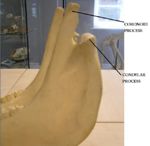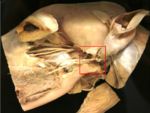Mastication
Introduction
Mastication is the process whereby food is broken down by mechanical digestion in the oral cavity. The cheeks and tongue function to position food over the teeth where grinding can occur.
Rumination allows food to undergo mastication more than once. Also called 'chewing the cud', it allows greater nutrients to be extracted and absorbed from the food particles.
Mastication requires correct muscle movements and jaw articulation.
Muscles of Mastication
The muscles of mastication are well developed.
Jaw Opening Muscles
- Digastricus muscle
- Origin: paracondylar process of occipital bone
- Insertion: angle of mandible
- Two bellies:
Jaw Closing Muscles
All jaw closing muscles are derived from the first visceral arch and are innervated by the mandibular branch of the trigeminal nerve (CN V3)
- Masseter muscle
- Origin: maxilliary region of skull and zygomatic arch
- Insertion: wide area on caudal side of mandible
- Several divisions
- Unilateral and bilateral contraction
- Also protrudes jaw
- Lateral Pterygoid muscle
- Origin: pterygopalatine region of skull
- Insertion: lateral aspect of mandible
- Also protrudes jaw (one-sided contraction)
- Medial Pterygoid muscle
- Origin: pterygopalatine region of skull
- Insertion: medial aspect of mandible
- One-sided contraction to close jaw
- Temporal muscle
Lateral Translation of Mandible
- Masseter muscle
- Contralateral medial and lateral pterygoids
Jaw Articulation
Temperomandibular Joint
- Articulation between the condylar process of the mandible and the mandibular process of the skull
- Compartmentalised joint for rotational movement and lateral slide (grinding)
- Fibro-cartilagenous disc between bones
- Synovial joint
- Caudal dislocation prevented by a prominent retro-articular process (enlargement of the fossa)
Mandibular Symphasis
- Rostral end of mandible
- Fibrous joint bewteen the left and right halves of the mandible
- Only in dogs and ruminants
- Precise occlusion
- Mandibular bones can move apart independently by rotation
- Stops jaw breakages (Canid)
Species Differences
Hebivores
- Large masseter and pterygoid muscles for extensive chewing
- Herbiverous species have a limited digastricus muscle
- In the horse the muscle insertion site for the masseter is large to snap jaw shut
Carnivores
- Large temporalis muscle for snapping the jaw shut, e.g. in lions and pitbull terriers
- Canids have a larger digasticus muscle than herbivores (but smaller in comparison with jaw closing muscles)
- In the dog large forces are needed to shut jaws so the point of articulation of the temporomandibular joint is level with the teeth
Links
Skull and Facial Muscles - Anatomy & Physiology
Video Pot 220 Lateral surface of the head of a dog
Pot 258 Lateral section through the head of a dog

